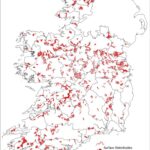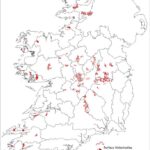Changes to the hydromorphology ranks as the second most significant…
Significant Pressures: Forestry
Forestry accounts for approximately 12% of land use in Ireland. Just under 50% of the total forest area is under public ownership, mainly managed by Coillte, and just over 50% is under private ownership1. Historically much of the afforestation carried out by the State has taken place on relatively undeveloped marginal land in upland areas, often on organic soils.
Forestry has been identified as the third most prevalent significant pressure, impacting approximately 12% of all surface waterbodies that are ‘At risk’ of not achieving their environmental objective under the Water Framework Directive (Table 1 and Figure 1). Waterbodies are categorised as being ‘At risk’ of not achieving their WFD objectives where the monitoring data shows evidence that water quality is impacted, and actions are required to deliver water quality improvements.
Forestry impacts a relatively high proportion of waterbodies with a High Ecological Status objective (22%) which are often upland vulnerable catchments in the headwaters of streams. These high-status headwaters are important ‘biodiversity reservoirs’ that play a role in restoration further downstream.







